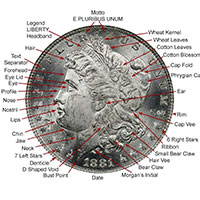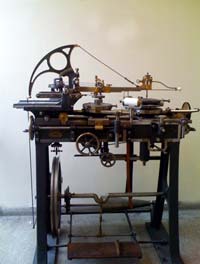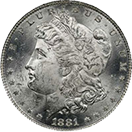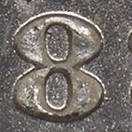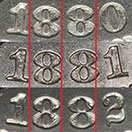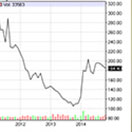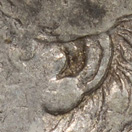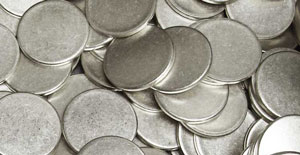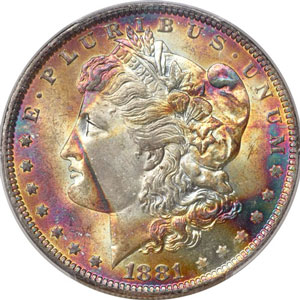Sources
Search
Contact
Home
We have learned through study that the 18 in dates is often placed in the same position and has the same characteristics for consecutive years. This means that these numerals were added early in the die making process since it is the same for all dies.
But we have also learned that the placement of the second 8 is not always the same and for a good reason. The date had to follow the same curve as the rim of the coin, and the last digit had to be the same height as the first 1. So when dates were different they only had the third digit to manipulate to finish the alignment.
In the 1881-O series there are no near and far date issues. For a full discussion of the date issues follow this link to our detailed study.
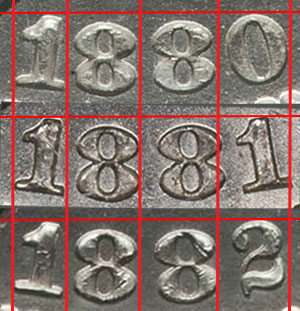
1s in Date
For the 1881-O the 1s in the date are not the same, meaning that different punches were used on the die to create the date.
The first 1 always has a rounded front base and slants upward.
The second 1 has a squared off front base and a more parallel area moving back toward the vertical shaft.
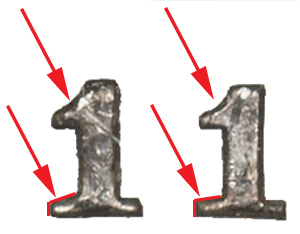
The Aging 1D
Submissions
Clashed Denticle
Date Issues
Encyclopedia
New Orleans and the Mint in 1881
The Devolving 5
One and Done
Two and Through
Fakes
Die Fingerprints
Pricing
The Devolving 27
For the 1881-O the 8s in the date on the 1881-O are from different punches and this can be verified visually.
The alignment of the openings in the first 8 is relatively straight.
The second 8 has a "pinched" look to it where it leans together on the left. On many 8s there is a notch on the left.
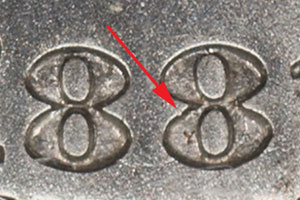
William Boyd Allison (1829-1908) was an early leader of the Iowa Republican Party, and represented northeastern Iowa for four consecutive terms in the U. S. House before representing his state for six consecutive terms in the U. S. Senate. During the Civil War he worked for the governor of Iowa and was responsible for raising four regiments of troops for the war.
During his time in the Congress he became a very influential member and eventually headed the powerful Senate Appropriations Committee. He is still the longest serving chairman of the committee. He was twice asked to serve as the Secretary of the Treasury and also offered the job of Secretary of State. He declined these positions preferring to remain in the Senate. He was a Republican, but also a centrist who both parties could work with and turn to when legislation needed compromise.
In 1878 he worked with Representative Richard P. Bland on what became the Bland-Allison Act which opened the door to silver backing of paper money (silver certificates) and the creation of the Morgan Dollar.
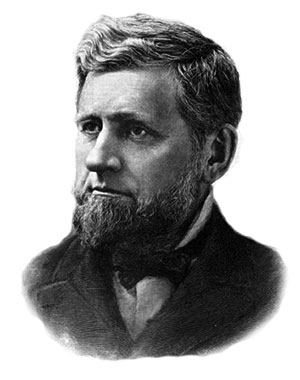
The term altered surface can be used broadly to refer to any circumstances where a grading service believes the surface of a coin was changed to enhance its value or grade. The could refer to a number of things like applying a material to a coin to make it more reflective or have greater eye appeal. However, this can be a subjective opinion and we have had coins graded in this condition that were later cleared on subsequent grading attempts. So one should take this as opinion and not fact if you believe you have an unaltered coin that is worth a second look.
The official PCGS definition is: "This No Grade covers anything added to the surface of the coin to either 'improve' its appearance or to cover marks. Surface alteration methods include adding: dental wax, putty, lacquer, nose grease, etc. 'Thumbing' is the application of a putty-like material to fill in marks, scratches, and other defects or to haze over portions of the coin. Coatings (such as lacquer), while intended to protect coins, result in a No Grade because it is impossible to determine the quality of the underlying surfaces." They classify altered surface coins as N-94.
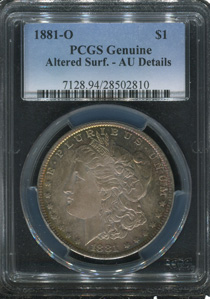
When coin hubs, dies, or planchets (blanks) were struck they were first softened or annealed. The softening allowed the object to receive the image being transferred. Since hubs and dies often had to be struck multiple times they could be annealed between strikes to re-soften the metal because the striking process could harden or temper the metal.
The annealing process was accomplished in an annealing furnace like the one shown here at the San Francisco Mint.
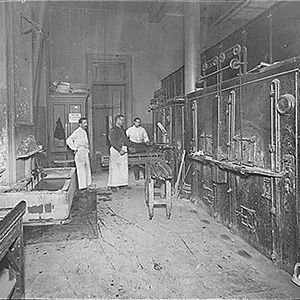
Coin dies generally fall into the categories of stationary, movable, or collar. The anvil die is the stationary die that the planchet rests on and is struck by the hammer die. The collar die holds the planchet in place and restricts the final coin size, while adding reeding to the rim.
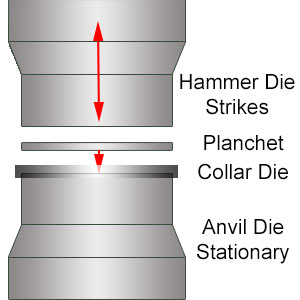
Toning of coins occurs naturally when silver coins come in contact with substances that react with the silver so that a thin film distorts reflective light. Toned coins often command a premium when they are colorful and have a great deal of eye appeal.
Unfortunately there are people who try to take advantage of the "toning premium" by faking the toning. There are any number of ways to create color including excessive and quick exposure to sulfur.
The three primary grading services are skilled at detection of faked color and will disqualify the coin from grading, like the example on the right.
There is a much more detailed discussion of coin toning on this web site and you can see many examples by clicking here.
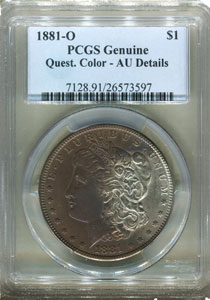
For current VAMing and VAMers this is the definition of a coin's variety according to Leroy Van Allen. Earlier attributions were also done by A. George Mallis prior to his death in December of 1999.
For numismatists authentication refers to a coin being designated as genuine. In years past this would have probably been performed by coin dealers or knowledgeable collectors. But as collecting as a hobby became more popular the prices for many coins escalated to a point that professional authentication became necessary and popular.
Today there are three primary authentication services: Professional Coin Grading Service, Numismatic Guaranty Corporation (NGC), and American Numismatic Association Certification Service (ANACS). All three offer similar services but the most popular is grading and certification. Each has different methods of encapsulation of coins but it is generally understood that if any of the three is willing to encapsulate a coin it is presumed authentic.
All three offer the collector a degree of protection from counterfeit coins.
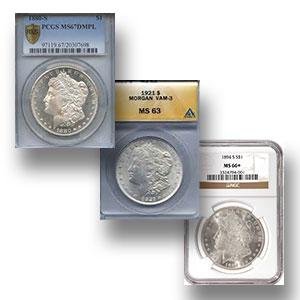
Basining is the process of polishing a die to create a slightly concave mirrored surface in the field. The process was also used to restore the fields when a die became worn, clashed, or otherwise damaged from use by holding the die against a 4 inch rotating emery wheel.
Basining also had the purpose of restoring the die surface to a completely smooth state after its final hardening (tempering). Basining produces a highly polished surface and coins struck first would have a highly polished field referred to as "deep mirror proof-like." As coins were struck the field became less polished and would produce coins in the "proof-like" variety.
Subsequent coins would be normal mint state coins with smooth but less reflective fields. In modern terms we might think of these like an upright sanding disk or grinding wheel used in lapidary work.
The picture to the right is NOT a basining wheel but the closest representation to one we could find and it closely matches sketches we have seen of others.
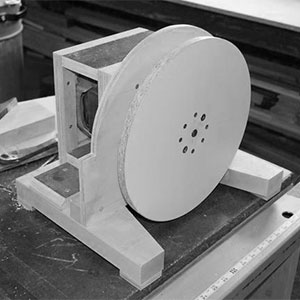
Beveling or beveled fields occur when a die is basined and not held perfectly perpendicular to the polishing wheel. When a die was not perpendicular to the wheel it could roll on an edge and polish unevenly.
Dies were often taken out of service to repair imperfections and polishing by hand rather than placing the die in a jig was an acceptable practice. Most often there was no field beveling.
Since this was sometimes (maybe often) done by hand when dies needed to be retouched the polishing could be slightly uneven. Many dies show signs of the uneven polishing, and many show a loss of detail at the field level as the polishing removed metal from the die surface.
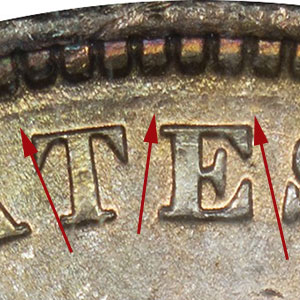
The Bland-Allison Act of 1878 was passed by the Congress to provide for additional coinage of silver. The original bill was offered by Representative Richard P. Bland and incorporated the demands of the Western advocates for free and unlimited coinage of silver. His was passed by the House but was unacceptable to the more conservative Senate.
Senator William B. Allison then offered up an amended version. The compromise act was adopted and required the U. S. Treasury to purchase between $2 million and $4 million worth of silver bullion each month at market prices to be coined into silver dollars. Attempts of the free-silver advocates to replace the act with provisions for unlimited silver coinage were defeated, as were attempts by the gold-standard forces to repeal the act altogether.
President Hayes and his successors weakened the act's effectiveness by purchasing only the minimum amount of bullion, but it remained law until replaced by the Sherman Silver Purchase Act of 1890.
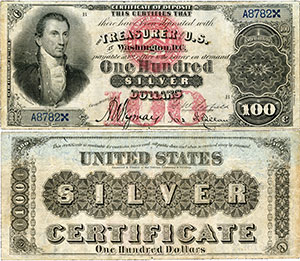
Richard Parks Bland (1835 – 1899) of Missouri, was a politician, lawyer, and educator from Missouri. He served in the United States Congress a total of twenty-four years between 1873 and 1899, representing at various times the Missouri 5th, 8th and 11th congressional districts. He was a Democrat and nicknamed "Silver Dick" for his efforts to promote a United States return to bimetallism and an advocate of the free silver movement.
Bland is best known for the Bland–Allison Act that he co-sponsored with Senator William B. Allison. Passed over the veto of President Rutherford B. Hayes in 1878, the Act required the U. S. Treasury to buy large quantities of silver from western mining interests and put it into circulation as silver dollars.
Bland was a U. S. Presidential candidate in 1896, seeking the Democratic presidential nomination but lost to William Jennings Bryan.
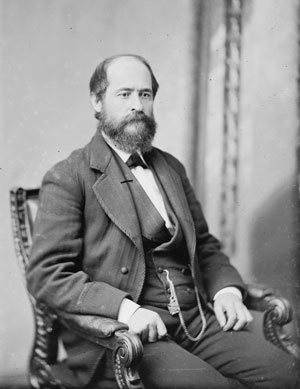
Blanking was a part of the coin manufacturing process and was the step where planchets were first created by punching them from a roll of silver. The blanks still had to be cleaned, weighed, and prepared in other ways to be ready for coining.
The strip of silver shown in this photograph is called webbing was recycled back to be melted and used in other silver ingots.
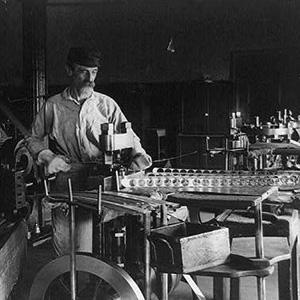
This is a slang term for coins returned from grading services without being graded. There are a number of reasons a coin can be excluded from grading like cleaning, alteration, artificial toning, or graffiti.
The term "body bag" is a obvious reference to a dead coin, but this is not always true. Grading services will accept coins for reconsideration, repairing, and often just have different opinions about condition. So if you have a coin returned ungraded from a service check to see if it should be given a second chance.
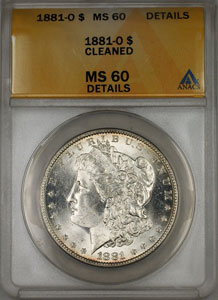
A Bourse is another term for a place of exchange. In European countries a bourse is another term for a stock exchange.
In numismatic or philatelic terms the word bourse is used to indicate a place where items are offered for sale or exchange on tables.
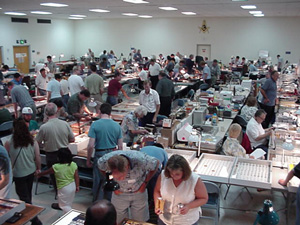
A broadstruck error occurs when the collar die is not properly in place. This allows the planchet to shift and lets the final strike to expand the coin beyond its normal diameter. The primary purposes of the collar die are to restrain the coin diameter during striking and to transfer the reeding to the rim.
Since this is a mechanical or production error it is not limited to any date, mint, or variety.
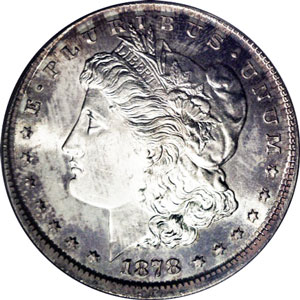
Any coin struck with intended purpose of placing it into circulation is a business strike coin. With Morgan Dollar collectors this usually includes coins below proof like.
In theory all Morgan Dollars could be circulated since any consumer could come to the Mint or a bank and request them. The Mint did not isolate proof-like and deep mirror proof-like coins from others, so technically any Morgan could be a business strike.
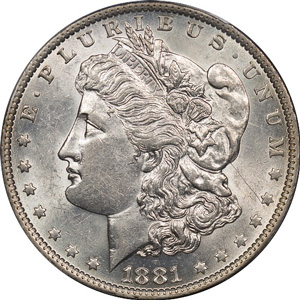
A coin cameo is very much like the cameo in jewelry terms, it just exists as the device on a coin. In the case of the Morgan Dollar it usually refers to Liberty's bust when it exists in a state that makes it stand out from the field in a frosted state.
The bust has this appearance because planchets and dies were given a weak acid bath to clean them before use. The planchets were washed in acid and then tumbled in a tub of sawdust. This left a fine white frosting on the planchet.
The final acid wash produced a slight frosting in the recesses of the die. The field of the die was given a final polishing and any frosting removed. When the first coins were struck the combination of the frosting on the planchets and the die produced coins where the frosting on the planchet was preserved in the die.
The frosting in the die wore away quickly, so cameos are often confined to DMPL and PL coins. To our knowledge there is no standard for a cameo and it is based on eye appeal.
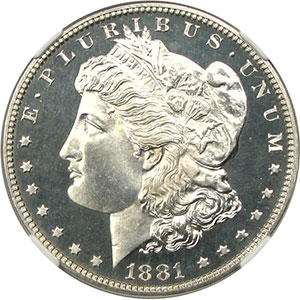
Clashed dies are of particular interest to VAM collectors because of their ability to define a new or unique variety.
When a clashed die is strong enough to include the transfer of a letter from one die to the other then is qualifies as a unique variety. Sometimes this is abbreviated on message boards as CDLT for "Clashed Die with Letter Transfer."
For a more detailed discussion of clashing you can follow this link.
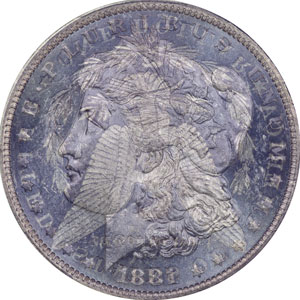
Cleaning is any process used to enhance the eye appeal or value of a coin. If faced with the choice of cleaning a coin it is almost always advised to not do it. Grading services are experts at detecting cleaning and will almost always refuse to give the coin a grade, or a grade without a notation. Generally coins in this class are automatically considered of lower value and holdered in a manner to note the problems.
Cleaning includes a number of different classifications or techniques and these are often referred to in numismatic literature.
See Dipping.
See Wizzing.
To avoid confusion, light cleaning was recommended many years ago and can be found in literature. Times change and they have with respect to this practice.
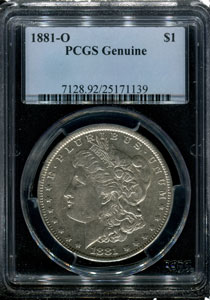
Coin presses are mechanical devices used to bring the obverse and reverse die for a coin together on a planchet to produce the finished coin. Throughout the history of American coining this process has improved to create efficiency and accuracy.
At the time of the minting of Morgan Dollars the press commonly in use was steam powered. Almost without exception the job of operating the presses was reserved for women. They sat on a stool in front of the press watched for coining errors and for the general operation of the equipment. The planchets were loaded in tubes of 50 to 100 and automatically fed into the coin press.
See milling.
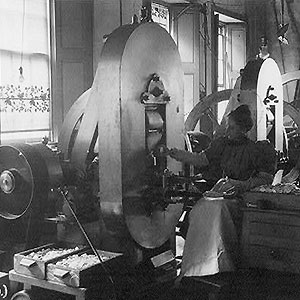
When a coin was struck there were actually three and not two dies involved. The obverse and reverse are obvious, but there was a third collar die involved.
For the Morgan Dollar the collar die served several functions. It held the planchet in place during striking; it restricted the expansion of the metal beyond the intended diameter; and it created the reeding around the rim. The collar was actually composed of several pieces that would close around the planchet, and then reopen after the strike to allow the finished coin to be ejected from the press. Collar dies were very slightly tapered on one end to facilitate the ejection of the coin.
The reeding on the rim is the vertical impressions and they can vary based on die construction. For the 1881-O all coins have 176 reeds on the rim.

Almost all metals are subject to corrosion when they come into contact with substances that cause the surface to form a new chemical compound. Silver is especially subject to corrosion, like a silver spoon might tarnish.
On Morgan Dollars this corrosion in its early stages can produce pleasing color or toning. But toning can go too far and is considered to be terminal when the color reaches a black state.
See our section on Toned Coins for a more detailed discussion.
With Morgan Dollars there is also die corrosion to consider. There are many examples of varieties with pitting and corrosion details being transferred from the die to the coin.
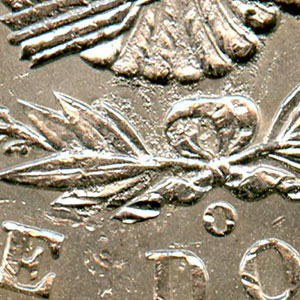
When you see a cotton plant in bloom and you see the white fluffy material it actually surrounds the seeds and in a natural environment would enhance the seed disbursement. The term "boll" is used to describe a rounded seed pod in cotton or flax.
On the head of Liberty there are two cotton bolls, perhaps a nod to the importance of cotton as a crop and an export for the United States, but also it could be a nod to the post war South and the rebuilding of the Union.
There are four cotton leaves on Liberty's head that are placed behind the cotton bolls and provide a backdrop for the bolls.
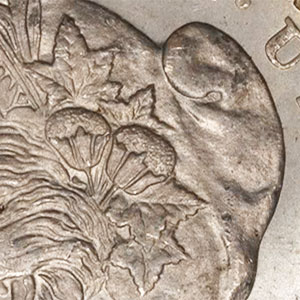
A counter clash is an unusual and rare error that occurs only when two dies are clashed, and then before they can be taken out of service they are clashed again. In the second clash a portion of the image is transferred back to the original die from the other clashed die.
In the example to the right from an 1880-P VAM 50A the obverse carries reverse clashes around the mouth and chin that would be normal signs of obverse to reverse clashing. But it carries a second profile that is not profile doubling because it does not follow the full outline of the bust.
There are no identified counter clashed 1881-O varieties.
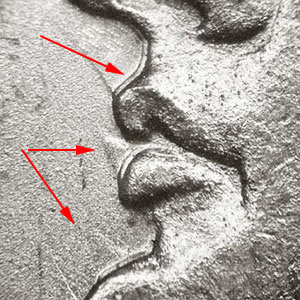
Cud is a term used to describe extra metal left on the rim or outer portion of a coin during striking. The extra metal is there because a portion of the die has broken away, leaving a cavity that can be filled during the striking process.
The collar die continues to constrain the diameter of the coin so metal from the planchet is free to flow into this area. Die cud is unpredictable and completely dependent on die wear, so it can appear anywhere on the rim.
There are no rim cud varieties identified for the 1881-O.
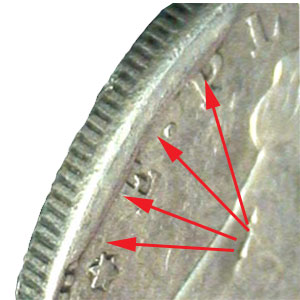
The term cull is used to represent a coin of little or no numismatic value. But if you are a low-ball collector then this is a trash or treasure argument. Certainly for lowball collectors the worse the better so long as the coin will grade.
While not as expensive as a full set of MS70 coins, PO01 coins can be more difficult to identify and grade. So to low-ball collectors, and we guess to us all, the term should apply to any ungradable coin regardless of the underlying detail.
Genuine N Grade coins are often heart breakers.
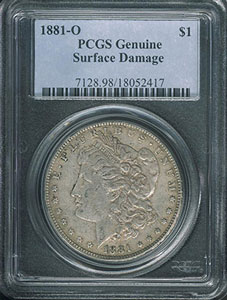
Deep Mirror Proof Like is a term used to describe coins struck with the highest possible degree of reflectivity in the fields. These are especially prized when the devices retain their frosty appearance creating outstanding cameo-like coins. Depending on the source this can be abbreviated as DMPL, DPL, or DM. These coins are as close to actual proof coins in appearance as possible without actually being proof struck coins. Theoretically any coin in any die state can be a DMPL coin because dies were pulled from service and basined again to improve the surface after wear.
When a die was basined the fields would be free of marks and polished with wheat flour. The very fine abrasive quality of the flour brought the coin's surface to a mirror like finish. When photographed the field of a DMPL coin often shows as dark or black. This is a result of the reflectivity and the camera, in reality these surfaces are like a true mirror. This image is from coin 26203551 an MS64+DMPL coin that is a VAM 28. Also see Proof Like.
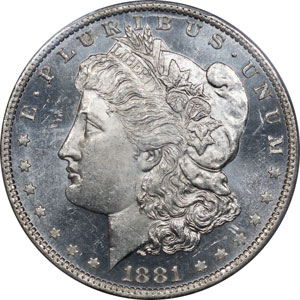
Denticle impressions can be left when the rim of one die comes in contact with another die. In the 1881-O series this occurs with VAM 18. When the impression occur they are often worn away quickly as the die is used in striking, so it is a fleeting error to catch.
In the 1881-O series this can be found on VAM 18.
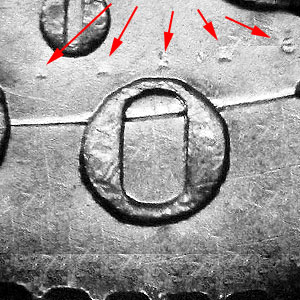
The word "denticle" is derived from the appearance to teeth. It refers to the rim feature on the Morgan Dollar that helps separate the field from the rim. They also have another use. When handling coins it is usually necessary to stack them. The denticles broaden the rim area and facilitate stacking.
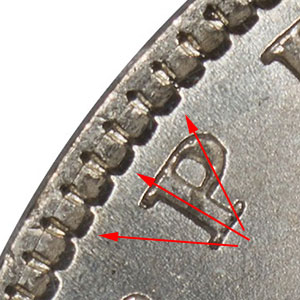
George Morgan's initial appears once on each side of the coin and is often used as a reference point.
On the obverse it appears at the intersection of the lower neck area and the hair curls.
On the reverse it appears in the bow on the left side.
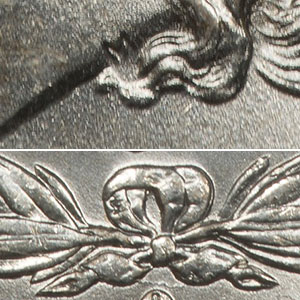
The term device refers to any feature on a coin that is raised from the surface (field). On the obverse of a Morgan Dollar it includes features like Liberty's bust, stars, and lettering.
On the reverse of the Morgan Dollar the primary device is the eagle, but would also include start and lettering.
For a complete list of features on both sides of the Morgan Dollar follow this link.
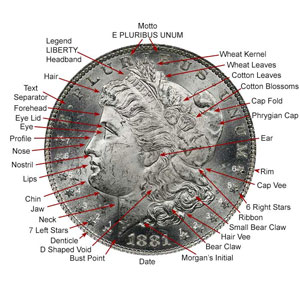
A die is a steel impression of a coin, but in reverse with the devices sunken below the surface. There is one die for the obverse and one for the reverse of a coin. When the two come together and strike a planchet it happens with such force that the planchet is momentarily made molten and flows into the recesses of the die.
When Morgan Dollars were made the die process was difficult and laborious and dies were often used beyond their practical life. The were often re-polished or used in ways that errors were imparted to coins, and this is often the source of different varieties (VAMs).
To understand more about dies follow this link.
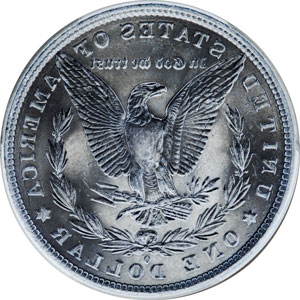
Die break and die crack are often used interchangeably, but technically a die break must have field displacement or raised metal. It is a distinction of severity is the separation of the metal.
While most die Breaks are listable, most die cracks are not, though they can still be used as die markers.
In the example to the right there is an extreme break toward the rim on this coin. Most die breaks will look like die cracks, but a little larger and with metal protruding from the surface of the coin.
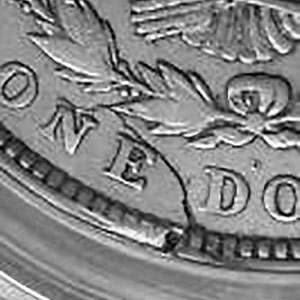
A die chip appears as a raised area on the coin because the chip leaves a void on the surface of the die. They are usually small and often used as die markers rather than varieties.
In the 1881-O series the most common die chip is the "Spike in 8" which appears in almost half the varieties. This would indicate that the die chip originated early in the die making process, perhaps on the master die.
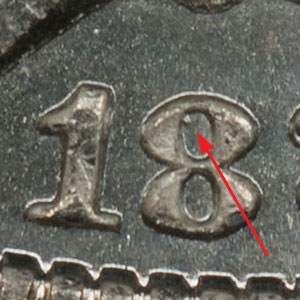
See Clashed Dies
A die crack is an opening in the surface of the die that resembles a quaking effect which results in a raised line being impressed on a struck coin.
Die cracks are very common in the Morgan series, and by themselves, are usually not a list-able feature.
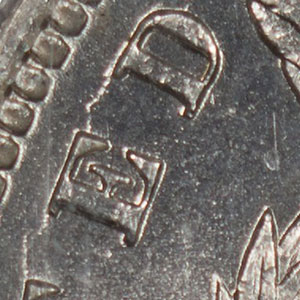
Die gouges come in all sizes, but not necessarily all shapes. They originate when some foreign object comes in contact with a die surface and leaves a mark. This creates a void that is then filled to become a raised feature of the struck coin. They differ from die cracks and die breaks in that they do not come from wear.
In the 1881-O series the most prominent die gouges are in a series of varieties with a gouge through DOL in DOLLAR.
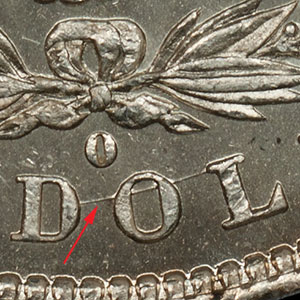
Often when two or more varieties share what appears to be common characteristics additional traits are needed to verify the die. These secondary features are referred to as die markers. If you submit a coin to LVA for attribution he will often identify these markers for you and photograph them to be sure you and others can spot them.
The photograph is from VAM 65 in the 1881-O series. It is Die A, but differentiated from others in that it has a series of vertical polishing marks in the hair.
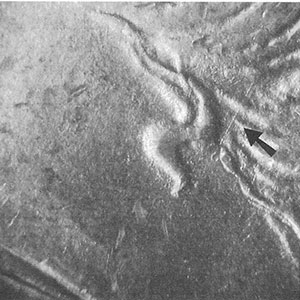
If a coin press operator recognized that a die had become damaged and that re-polishing the die would correct the issue then the die would temporarily be taken out of service for repair. One obvious example is die clashing where the damage would be readily apparent and probably known when the press was operated without a planchet.
Although usually found on the field level, the polishing marks can appear within devices. The example on the right is the 1881-O VAM 64 and shows die polishing lines on Liberty's forehead.
This type of abrasion should not be confused with wizzing which is not a part of coin production.
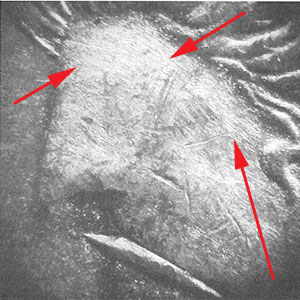
Die Poop is a term used to describe very minor die features even lower than die markers. Think of them as secondary die markers. We have not seen this term used quite as often of late. As more collectors get into digital photography of coins what once seemed like minutia now seems like just identification marks.
Once machinery was introduced to the Mint the engraver no longer carved his image directly into the surface of the die. By the time of the Morgan Dollar when a Mint engraver actually went to the die itself and made corrections or touched up features to make them more prominent this was referred to as die sinking. Perhaps the term originated from the taking away of metal and causing the device to "sink" below the surface of the die.
Closely associated with this term is the job description of the engraver who performed this task. His job was that of Die Sinker. In all likelihood all the Die Sinkers were in Philadelphia since none were listed in the 1881 New Orleans list of employees.
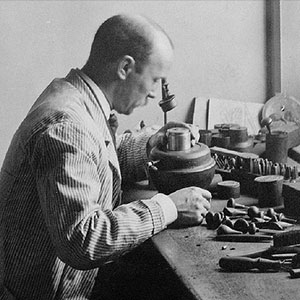
This is purely a VAMworld term used when a list of individuals interested in specific Date/Mint pairings are identified.
Dipping is a form of cleaning where the coin in submerged in any number of solutions that might remove tarnish, dirt, or other substances. Experienced collectors and grading services can often detect the process and avoid these coins.
For each VAM there is a coin used to identify the variety. It is almost always the coin that Leroy Van Allen examined when he made his determination that a new variety existed.
Some services, such an ANACS ans VSS, will label discovery coins. This is especially helpful in future years when the discovery coin is needed to compare to others to determine differences.
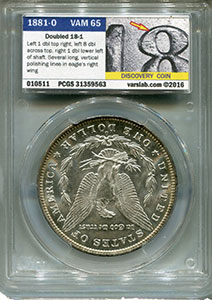
Double struck coins are a mechanical error where a coin fails to fully eject from the coin press and is struck again off center. Proof coins were intentionally struck multiple times to sharpen detail, so they are not a part of this group.
We are not aware of any double struck 1881-O coins surfacing, but it is always possible. The New Orleans Mint was not known for outstanding quality control so finding one is not out of the realm of possibility.
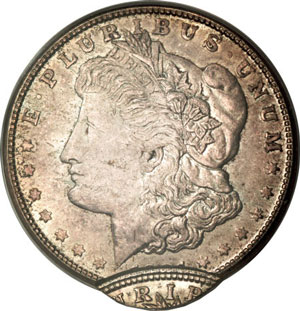
When a coin die is doubled it can obviously be either the obverse or reverse die. The acronyms for these is DDO and DDR. One of the most famous Doubled Die Varieties is the 1888-O "Hot Lips."
In the 1881-O series there is nothing as pronounced or obvious as the 1888-O Hot Lips, but there are a lot of doubled profile coins. The most prominent is the VAM 28 Doubled profile that actually comes in three sub-varieties.
An interesting thing about the VAM 28 is that it most often comes in either PL or DMPL condition. So we would assume that a large quantity of these were set aside in the vaults right after basining and never circulated.
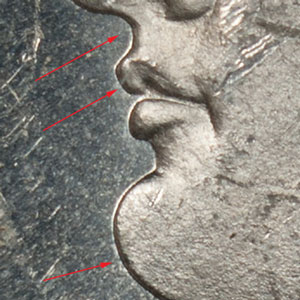
One of the most prized clashed varieties for any date/mint series is a Clashed E. The clash occurs when the E from Liberty's headband is transferred to the reverse die.
The clash must be a very hard one for the transfer to take place because LIBERTY in the Headband is a negative and not a positive device. The transfer is also interesting because it appears as a positive image on the reverse beside the bow.
There are no identified Clashed E varieties in the 1881-O.
To see more on clashing follow this link.
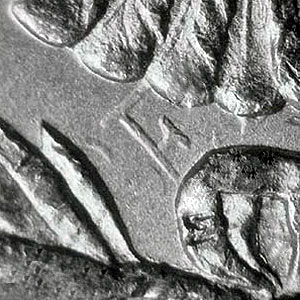
Theoretically there is an early, middle, and late die state for every die, we just might not have found all examples. But the sequence often goes in the opposite direction where someone finds a coin with unusual features. If these features are a result of die wear then it can be assumed that there exists an earlier version where the wear features do not exist.
For example, if a clashed version of a new variety is found it is safe to assume that somewhere there is a coin that is not clashed, and that coin would be an earlier die state. A good example in the 1881-O series is VAM 55 and VAM 55A. The VAM 55A is one of our discoveries, but it is clashed. So logically there is an unclashed version, VAM 55.
Another good example is the VAM 6 and VAM 6A. The VAM 6A has the familiar Spike in the first 8, but this was a later development in the obverse die.
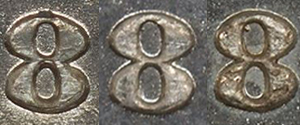
Finger feed gouges are most likely a die alteration caused by the mechanization of the feeding of planchets or the removal of coins from the coin press. Assuming the gouges originated with the dies, then the error is caused by contact with the feed mechanism. This seems likely since the gouges always seem to appear in the same areas of the upper reverse.
The gouges are often described as excessive polishing, but they are in fact a result of the mechanization of the coin press. Another indicator as to origin may be the concentration of identified VAMs in the 1921 series. Whatever "improvements" in the coining process had taken place in the intervening years may have isolated the error to this series.
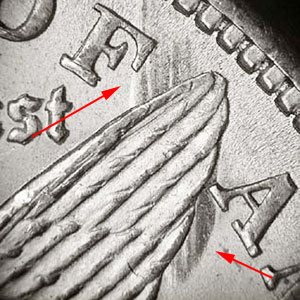
The field of a coin is the flat surface that provides the background from which all the devices rise. It is the lowest surface on the coin, and therefore the highest surface on the die. When die polishing is discussed it is most often referring to the field. This is the surface where die cracks, die breaks, cuds, gouges, and other features originate.
The green dots are all in the field level of this coin.
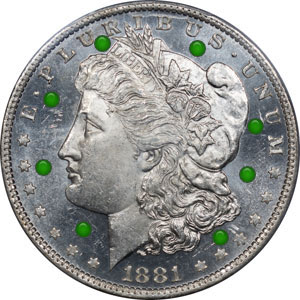
When a die crack occurs in the field of a die there can also be a shift in the surface of the field. When this shift results in one side of the field being lower than the other this is referred to as a field displacement.
We have seen no examples of field displacement in the 1881-O set, but it is an error that could show up on the next coin, or never.

Grading services will disqualify a coin from grading if they detect the rims have been filed in an attempt to improve the coin's appearance. Coins pick up dents and dings on the rim and these will drop the coin's eye appeal. Sometimes collectors believe they can recapture some of this appeal by trying to restore the circular appearance of the rim.
PCGS gives these coins a classification of N82 - Filed Rims
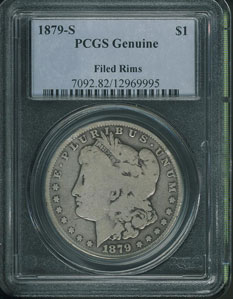
Usually when a device is missing from a coin, (date digit, star, letter, etc) it is because the die became filled with something in that area. Because the metal actually had to flow into all areas of the die, the foreign matter kept it from from that area.
In the case of grease it could flow into any area and prevent a full strike. Often a lack of hair detail or breast feather detail is caused by excessive grease.
When VAMing was a new hobby filled dies could receive a variety designation, but today they are considered to be a temporary die state and not a die alteration.
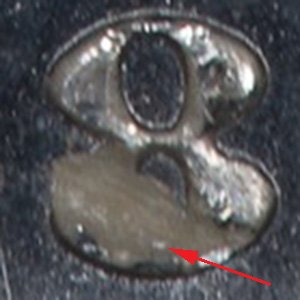
Henry S. Foote was a well-educated Virginian who had moved west after college. He was an important figure in the Compromise of 1850 that delayed the Civil War. But he is also remembered for drawing a revolver and pointing it at another Senator during the heated debate. He had to be wrestled to the floor and restrained.
At the outbreak of the Civil War he was living in Tennessee and was elected to the First and Second Confederate Congresses. But he also defected to the North in early 1865 and ultimately traveled to Canada and England as a man without a Country. After the War he returned to the United States and lived in Washington. He served as Superintendent of the Mint from 1879 until 1880.
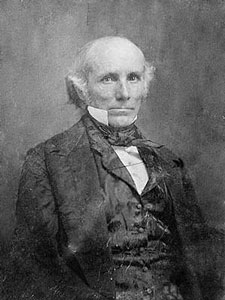
Receiving a coin back from PCGS in a "Genuine" N Grade holder is like winning a participation trophy. They are certifying that your coin was minted at the US Mint but with problems that preclude grading. If you are a lowball collector you are very familiar with the N grades as you pile them up working on your set. The classifications are:
82 Filed Rims
83 Peeling Lamination (Will not holder)
84 Holed and Plugged
90 Not Genuine (Will not holder)
91 Questionable Color
92 Cleaning
93 Planchet Flaw
94 Altered Surfaces
95 Scratch / Rim Dent
97 Environmental Damage
98 Damage
99 PVC Residue (Will not holder)
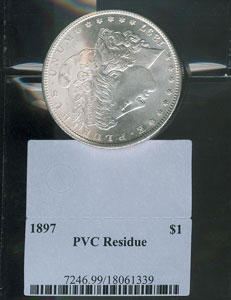
Gouge
See Die Gouge
Our collection offers a large visual reference to grading. You can learn a lot just comparing your coins to the ones in our collection and hope you enjoy it. Additionally there is a page for each grade with more information on how the grading experts classify coins.
The term "Right Hair Vee" is used to indicate the area toward the back of Liberty's head where the clashed letters "st" would appear on a clashed coin.
The term "Left Hair Vee" or "Lower Hair Vee" is just to the right of the Designer's Initial.
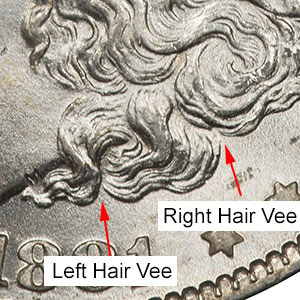
Coin dies generally fall into the categories of stationary, movable, or collar. The anvil die is the stationary die that the planchet rests on and is struck by the hammer die. The collar die holds the planchet in place and restricts the final coin size, while adding reeding to the rim.

Hayes, Rutherford B.
When the Mint was reopened in 1879 President Rutherford B. Hayes appointed former U. S. Senator and Mississippi Governor Henry Stewart Foote to be the superintendent of the operation.
Hayes was elected president in 1876 in perhaps the most contested election in history. Following the Civil War votes in the heavily Democratic South were often questioned. In the 1876 election votes in Florida, South Carolina, and Louisiana were questioned and ultimately reversed in favor of Hayes. The election was so contentious that in South Carolina and Louisiana each party temporarily inaugurated its own government.
The Presidential election was eventually decided by a committee and Hayes became the 19th President. The importance of the election was that the compromise over the election ended the Reconstruction Era in the South following the Civil War. This eventually led to the reopening of the New Orleans Mint.
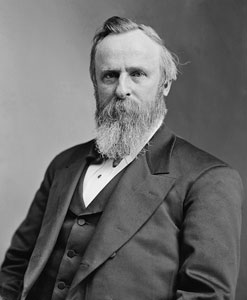
It is the Hill Pantograph (with US Mint specified modifications) that was used to create the hubs for the Morgan Dollar. C. J. Hill, an English inventor, patented and produced the lathes for the Royal Mint in the 1870s and then later sold the patent.
Often the Janvier Lathe is incorrectly identified as the Morgan Dollar lathe, perhaps because there a many photographs available. But it was the Hill Lathe that was used.
For a more complete discussion of the reduction lathe and processed follow this link.
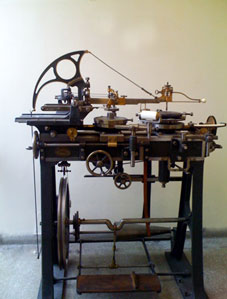
The Hit List 40 group of VAMs is intended to be an updated short list of popular and rare VAMs. The Hit List 40 group was compiled by Jeff Oxman and the Society of Silver Dollar Collectors. The last update was apparently in 2009 and can be revised as needed by the authors.
In the 1881-O series two VAMs make the Hit List 40.
Follow this link to VAMworld to see the current list.
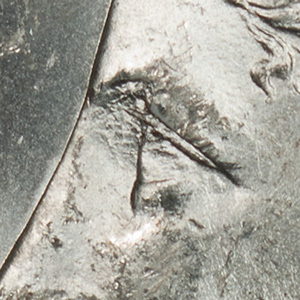
We would probably define a "Hoard" as any group of Morgan Dollars put away from circulation for a number of reasons. There are personal hoards, often stashed away for fear of government or economic collapse. There are government hoards put away awaiting a decision on the disposition of the coins, thus the GSA hoard. There are accidental hoards where people or just set aside coins that were later discovered by family members, and sometimes proved to be valuable.
Some of these are so famous that whole books have been written about unusual discoveries of coins and most are worth the time to read just to understand human nature.
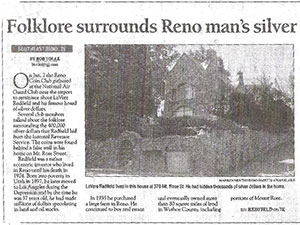
Jeff Oxman first published the Hot 50 Morgan dollar book back in 2000. These varieties were identified as coins of special interest to collectors in addition to the Top 100 Morgan VAMs. At the time of its compilation many of these varieties were extremely difficult to find, and often commanded large premiums.
One 1881-O makes the list, the VAM 27 - Double Ear.
The Hot 50 book was out of print but was re-published in 2008 so it is now readily available. All of these VAMs are recognized by the major grading services.
Follow this link to VAMworld to see the current list.
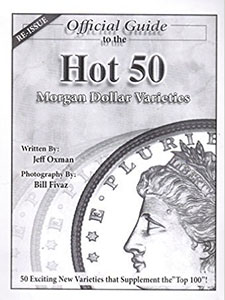
Understanding hubs (and dies) is a discussion that we cover in the web site in greater detail than can be explored here. The short definition is that a hub is a metal cylinder that the engraver's design is first transferred to in the die making process. The hub is an exact copy but reduced to the final die size.
With Morgan Dollars this reduction was accomplished using a Hill Pantograph designed by C. J. Hill in England. This pantograph had some limitations (including Mint education) and was only used to transfer the primary device on each side of the coin.
For a more complete discussion follow this link.
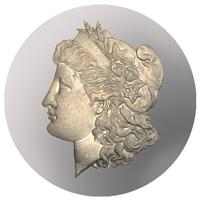
In the process of making the working dies for production it was necessary to go through the steps of reduction, master hub making, master die making, working hub making, working die making. Each step required repeated annealing and tempering to transfer the image in each step. It was not until the late 1880s that hydraulic presses capable of more accurate image transfer were available. Any misstep in the process could result in doubling of the image (or parts) on either the master or working hub. From that point forward any error would be replicated in the next steps. So errors in the master hub transferred to all dies, and errors in the working hub transferred to the working dies struck from that working hub.
The process was especially difficult because multiple strikes of the die from the hub had to be made for a complete transfer. Annealing had to take place at each step to soften the hubs and dies, so alignment errors were easily possible. It was also possible for a die or hub to come out of the annealing process a slightly different size. When considering the complexity of this manual process the miracle may be that any coins were struck without errors.
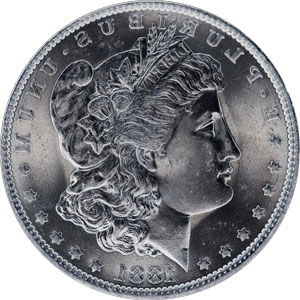
The term "Incuse" is defined as an impression hammered or stamped onto the surface of a coin. On Morgan Dollars the most common form of this comes from clashing of dies.
The "Incuse M" references originates with the clashing process and is most often associated with the Designer's Initial "M" at the base of the neck being transferred to the reverse. This M appears just above God in the motto and can move positionally just a little.
The incuse M is often difficult to detect without proper light and magnification.
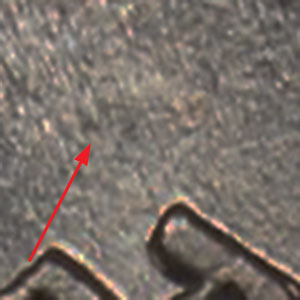
Infrequent reeding refers to coins where the vertical edge reeding is spaced wider than normal. For the 1881-O there are no known examples and all the coins have 176 reeds.
Reeds were imparted to the coin rim from the collar die in the striking process, so the die itself would have to have the different spacing. It is thought that the Mint experimented with different spacing from time to time and that the different coin reeding is a result of those experiments.
While a real pain, reeding can be used to detect counterfeits. There are also other reeding errors such as overlapping reeding.
The example on the right is NOT from a Morgan Dollar, only used to vividly illustrate the difference in narrow and wide reeding.

The Janvier Lathe was invented by a Frenchman, Janvier et Duval. It is often mistaken for the reduction lathe used for Morgan Dollars. But it was not purchased until Theodore Roosevelt insisted that it be acquired for the production of the Saint-Gaudens double eagles that the US Mint acquired one.
It was a definite improvement over prior reduction lathes and is in use today for some applications outside the Mint. Proving to be relevant for over 100 years it must be a phenomenal piece of technology. The Morgan Dollar lathe was the Hill Pantograph.
For a more complete discussion of the reduction lathe and processed follow this link.
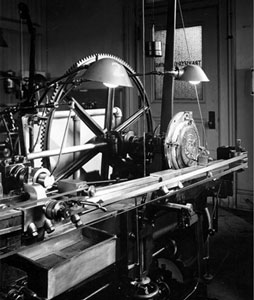
A flaw in the surface of a coin where there is still metal attached is called a lamination. It is distinguished from a more severe problem, called a planchet flaw, where the lamination is missing and only a hole remains. We have seen it also referred to as "Peeling Lamination."
Laminations can occur at any area of the coin's surface because it originates with the planchet. The primary source of planchet flaws is metal impurities and issues with the annealing of the planchets.
Prior to striking the flaw in the planchet would be almost impossible to detect.
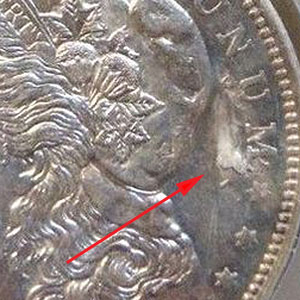
The noted Civil War author Shelby Foote was famous for saying that everyone's life can be divided into thirds and there is a significant event in each third that had an effect on the remainder of their life. But until they die you don't know what each third was.
So it is with Morgan Dollars. When one "dies" we know that there is a late die state, and so long as another does not materialize with a later state then we should be able to determine the early and middle state.
Late die states are often designated as such because of excessive polishing, cracking, double clashing, or just expansion of flaws evident in earlier states.
We are just beginning to study die states and will have more on them in time. But a very straightforward example may be the familiar Spike in 8 varieties where the spike grows over time. The die is obviously in different states of wear.

On both the obverse and reverse of a Morgan Dollar there is a legend and a motto.
The word legend can be used to identify the writing that appears on an object, so it fits nicely into the description of the word "LIBERTY" in the headband that Liberty wears.
On the reverse the legend is the words "The United States of America" which would also fit that definition.
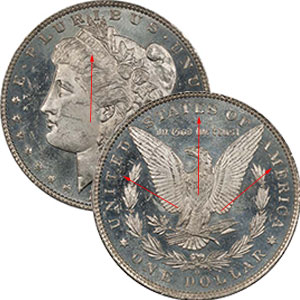
Linderman, Henry Richard
Henry Richard Linderman was a doctor who practiced medicine in both Pennsylvania and New York. He studied under his father and also completed medical courses in New York City.
From 1855 until 1864 he was the chief clerk of the Philadelphia Mint. He left the mint for a year but returned in 1866 as the director of the Philadelphia Mint. He served as the director until 1869. He later served in other Mint capacities until 1873 when he was appointed Superintendent of the Mint. In that capacity he had control over all Mint activities and was an advocate for the gold standard.
As the Superintendent of the US Mint and made the decision to ask the Royal Mint to recommend an engraver who could improve the coinage of the United States. It was his actions that led to the immigration of George T. Morgan, the designer and engraver of the Morgan Dollar.
Linderman died in 1879, the year after the first Morgan Dollars were struck.
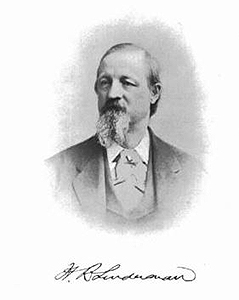
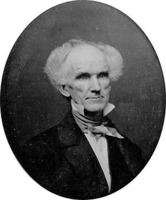 Longacre Doubling is named for James B. Longacre the fourth Chief Engraver of the Mint from 1844 to 1869. It often appears as a shadow outline of a device and is caused by the bunch going to deep when struck. As a result the shoulder of the punch makes a slight impression in the die.
Longacre Doubling is named for James B. Longacre the fourth Chief Engraver of the Mint from 1844 to 1869. It often appears as a shadow outline of a device and is caused by the bunch going to deep when struck. As a result the shoulder of the punch makes a slight impression in the die.
Longacre doubling often wore off as the die was used, so it is possible to find the same VAM with and without the doubling effect. It is often found with the effect only on one side of the device probably indicating that the engraver did not hold the punch perfectly perpendicular to the die.
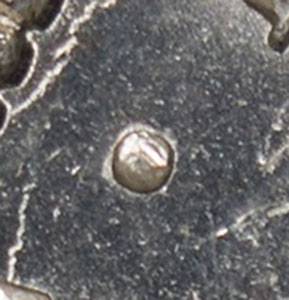
Very simply these are the tail feathers that protrude from beneath the crossed arrows and olive branch. The upper tail feathers would be just above this intersection.
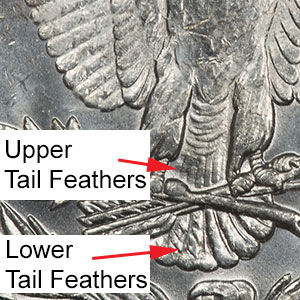
Whenever a new variety is certified by Leroy Van Allen he provides detailed photographs of the key features on the coin that differentiate it from others. These are done with enough magnification to make identification of other similar coins possible.
Once you have seen one they are instantly recognizable.
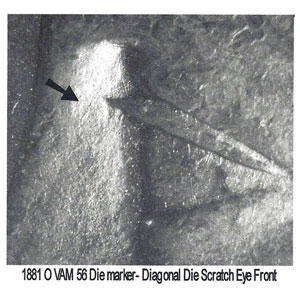
Machine Doubling
See Strike Doubling
In the era of Morgan Dollars the term milling would have referred to as one where the edges of planchets were compressed, smoothed, and slightly raised. This process is sometimes referred to as "upsetting."
Over the history of the Mint various equipment was acquired or invented to facilitate both the quality and speed of the process. However it was mechanized the process involved palling the planchet through a series of rollers that would compress the rim of the planchet. This forced it to rise slightly and in the process insure the roundness of the planchet. This process also facilitated the planchet's ability to pick up the reeding from the collar die when struck.
Coin press pressure was also something that was less precise than today and having the rim raised helped compensate for this issue. In this image the employee is cutting planchets in the foreground and the milling machine appears to be to his left in the background.
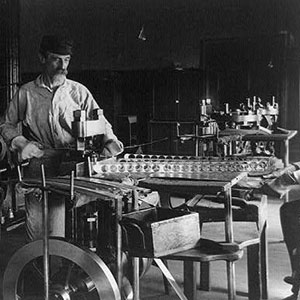
Mintage refers to the quantity of coins struck for a particular year and mint location. For the 1881-O there ware 5,708,000 coins struck.
However, for all Morgan Dollars the key is survivability. With the Pittman Act 270 million Morgan Dollars were melted to help supply bullion to other countries. There is no way to actually know, but we believe there are about 570,000 surviving coins, with 210,000 being in mint state.
For a more complete discussion of the issues on mintage for all Morgan Dollars click here.
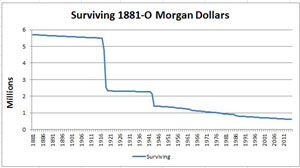
Misplaced digits refers to partial digits found at unusual or inappropriate places on dies. Since it is likely that the date was added to the master die and not the working die then this must have occurred at the Philadelphia Mint before dies were shipped to branch mints.
There is speculation that this was done to working dies, but this seems improbable given our research on dies. Other possibilities are a date punch bouncing after being struck. Or as suggested on VAMworld that the mint worker was testing the die hardness in an obscure place that he thought would be erased with the addition of the denticles or other feature.
We are not as convinced of the die hardness testing because the examples we have seen seem to strongly struck to have just been testing hardness. To date there are no identified misplaced digits in the 1881-O series, but maybe there is one out there.
The example to the right is an 1880-P from VAMworld.
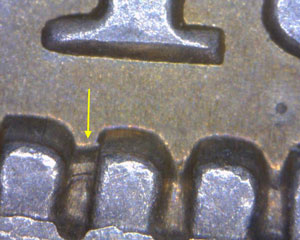
George T. Morgan came to the United States from England at the request of Mint Director H. R. Linderman and on recommendation of Charles Fremantle the director of the London Mint. Director Linderman felt that additional expertise was needed in the engraving area and was somewhat dissatisfied with the work of William and Charles Barber.
George Morgan proved to be as good as his recommendation and continued to work at the Mint for the rest of his life. There was a lot of friction between the Barbers and Morgan and this conflict reared its head from time to time.
George Morgan became the chief engraver after the death of Charles Barber in 1917. Under his direction many high quality coins and medals were struck, but he is most remembered for the Morgan Dollar.
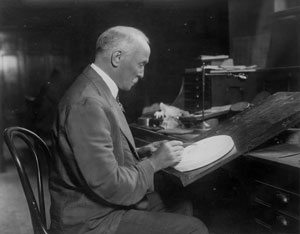
On both the obverse and reverse of a Morgan Dollar there is a legend and a motto.
A motto is defined as a sentence, phrase, or word inscribed on something as appropriate to or indicative of its character or use.
On the Obverse the motto is the words "E PLURIBUS UNUM" that circles the coin near the rim.
On the reverse the motto is the words "In God We trust".
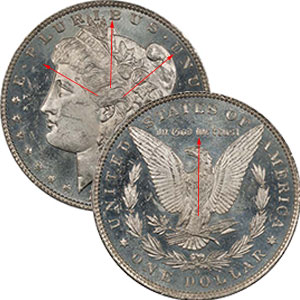
The primary side or face of the coin containing the Liberty bust and date. To see an explanation of all the obverse features follow this link.

The term occluded gas refers to gas that was trapped in the silver ingot and then passed along in the planchet making process until it remained within the planchet. The areas where the gas is trapped would appear to be raised bumps or bubbles under the coin's surface causing a slight bulge.
While this seems plausible, it also seems like it would be rare. There are so many places in the coin making process where the gas could be expelled that for it to survive would be rare.
However there are VAMs that have been identified with this issue such as the 1904-O VAM 35A. The issue with identification is that the bubbles can appear as small die gouges.
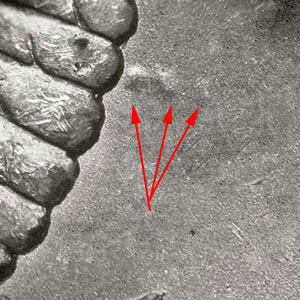
When a planchet was not properly seated over the anvil die in the coin press it was possible to produce a coin that was off center. While minor versions of this are quite common, significant off center struck coins would have been culled in the post production inspections. Severely off center strikes are not common and can be highly prized.
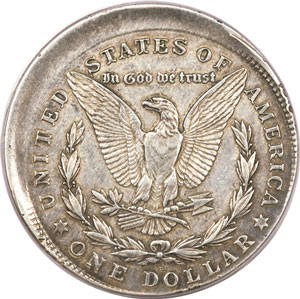
Olives
In the eagle's talons it holds an olive branch signifying peace. The olive branch also has several olives on the top part just to the left of the eagles right talon.
How the olives appear can depend on a lot of factors. From the hub to the die the clarity of the olives can vary. Usually this is described as the olives being separated or not. All this means is that they show as two separate olives or as a blended one as shown to the right.
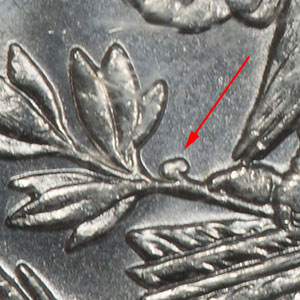
Overdates are a phenomena where an obverse die is reused from one year to the next and in the process the prior date is not completely removed from the die. When executed properly the old date was polished away from the die and the new date was then stamped in the proper place.
For Morgan Dollars the overdates are concentrated in just a few years and it would be interesting to know more about the Mint employee who did the work. The most common year for the overdate error is the transition from 1879 to 1880.
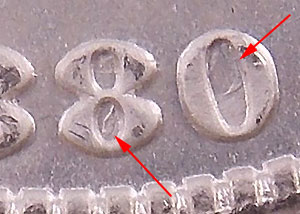
Collar dies were made by drilling a hole through a piece of steel that was slightly smaller than the finished coin. Then a with a tool called a "drift" or "drift punch" was driven through the hole to cut the reed pattern into the collar die. The number of reeds was based on history and requirements of the press being used.
The drift punch was a cylinder with grooves equal to the number of reeds, and horizontal channels used to allow metal to escape during the punching process. Any misalignment in the drift punch during the collar die making process could produce additional or overlapping reeds in the collar die.
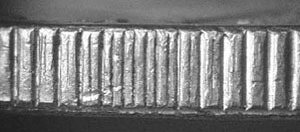
See Off Center Strike and Railroad Rim
The process of separating metals from each other and from foreign material as a part of the assaying of ore or metal bars. For the mints this was often the separation of gold from silver, but it could have been any metals. The customer was charged a fee per ounce for the parting operation. The process was often done with an electrolytic process much like electroplating to draw one material from the other.
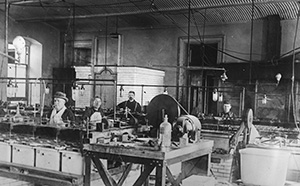
During the process of creating new coin designs engravers would reach a point where either approval or examination required a coin to be struck. Sometimes there were struck from less expensive planchets, but often from the final coin material. At times one might see these referred to as "die trials."
These coins are termed "pattern coins" and there were several for the Morgan Dollar as George Morgan worked toward his final design. No doubt the disagreements with the Barbers did not help. Perhaps the biggest struggle was with the reverse and the design for the eagle.
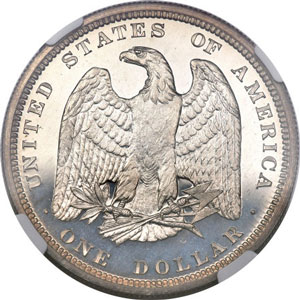
If you are studying Morgan Dollars and the term "Phrygian Cap" is used it is referencing the cap worn by Liberty.
The term Phrygian Cap originates in Europe where it came to be associated with freedom and liberty. It is a soft, conical, felt cap usually pulled slightly forward. The name may be a confusion or alteration of the term "pileus," a cap worn by freed slaves in ancient Rome. We tend to associate it with the scenes of the French Revolution seen in old films.
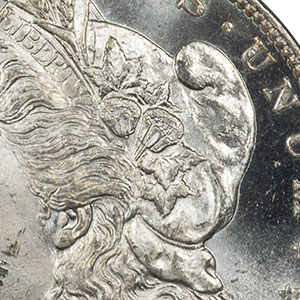
Pitting refers to a breakdown of the die surface in a way that resembles tiny pebbles. It is sometimes incorrectly referred to as rusting, when in fact it appears as pitting. It is correctly described as a failure in the die metal and is sometimes also referred to as spalling.
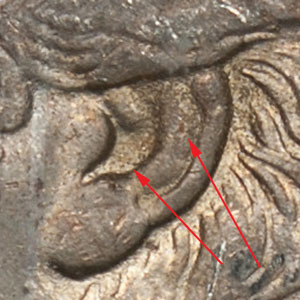
A planchet flaw is a condition that is independent of a coin's VAM since a VAM originates from the die and not the coin blank. We have seen discussions about cracked planchets, occluded gas, holes, peeling laminations, and more. All of these originate with the making of the planchet and in all likelihood the source is either annealing or trapped impurities in the metal.
A more interesting discussion may be "How does a planchet flaw effect grading?". We would assume that the flaw can have a major impact on eye appeal, but is a well struck coin a well struck coin regardless of planchet flaws?
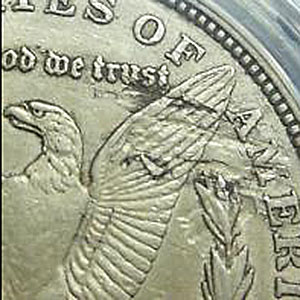
Post mint damage refers to any and all "things" you see on a coin post striking. Take your pick of scratches, bag marks, dings, scrapes, nicks, etc.
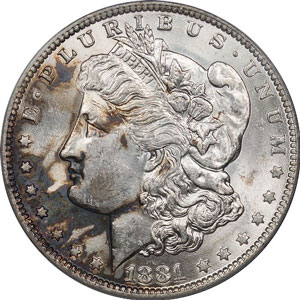
Polishing
See Die Polishing
A proof-like (prooflike) coin is a business strike but with some reflectivity remaining from a recently basined die. It fits between a Deep-Mirror-Proof-Like and normal business strike in terms of reflectivity. It was created as the basined die started to lose some of its luster.
When photographed a DMPL and PL coin will often look the same because how the camera deals with the reflection. Also confusing the situation is that the standards for PL and DMPL vary by grading service and grader. It is somewhat subjective and in the hands of the grader.
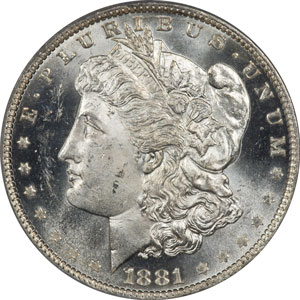
Years ago coins were often stored in clear 2x2 flips made of polyvinylchloride. Collectors over the years learned that these flips transmitted a greenish tone to the surface of the coin. PCGS and other services give these coins an N-97 grade, but they can be repaired.
The polyvinylchloride residue can be removed with a light acetone dip, or if appropriate it can be restored by most grading services. Since actually ruining a coin with a PVC flip would take a long time the damage can usually be repaired.

A radial die crack is one that runs from the center of the die to the rim, thus mimicking the radius of the coin. Since this is a term of direction and not severity we assume there can be both radial die cracks, breaks, and field displacement.
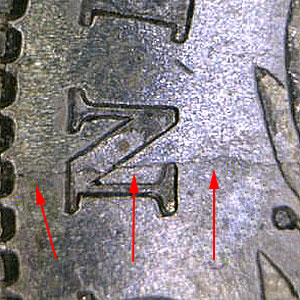
A partial collar railroad rim refers to a coin that has been slightly off struck. The coin in struck in a way that places the denticles at the edge of the coin, producing a look like railroad tracks.
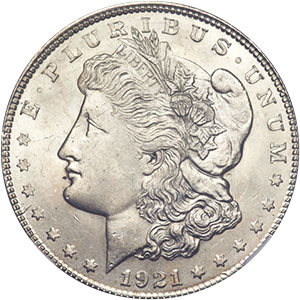
Reeds were imparted to the coin rim from the collar die in the striking process, so the die itself would have to have the different spacing. It is thought that the Mint experimented with different spacing from time to time and that the different coin reeding is a result of those experiments.
While a real pain, reeding can be used to detect counterfeits. There are also other reeding errors such as overlapping reeding. When first introduced features like reeding and edge lettering kept coins from being clipped so that the metal content could not be altered.
The example on the right is NOT from a Morgan Dollar, only used to vividly illustrate the difference in narrow and wide reeding. Also see the discussion on Infrequent Reeding.

Retained Cud
See Cud
The secondary side or back of the coin containing the eagle and mint mark. To see an explanation of all the reverse features follow this link.
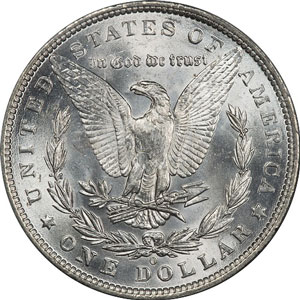
The rim of a coin is the upturned outer edge of both the obverse and reverse of a coin. It serves several purposes, not the least of which is to make the coins stackable. The rim must therefore be slightly higher than any device on either side.
On a Morgan Dollar the rim is separate from the denticles and the edge reeding.
The rim begins to be formed in the coin making process when the planchets are processed through a machine called an "Upsetting Machine." This raises the edge of the planchet and allows it to fit into the coin press easier, and we would presume make stacking easier before coining. This process was also known as ""milling."
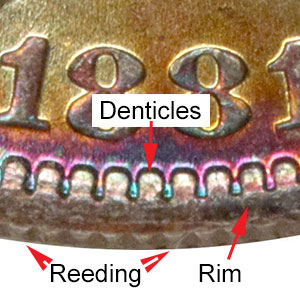
A clipped planchet or rim clip refer to the same condition. When the missing portion is significant then the coin is analyzed as a mint error. When the area is small then the coin is evaluated just based on the quality its detail and wear.
The examples we have seen of rim clips on VAMworld have the missing detail on both the obverse and reverse, so it is not from a damaged planchet but must be from post striking damage.
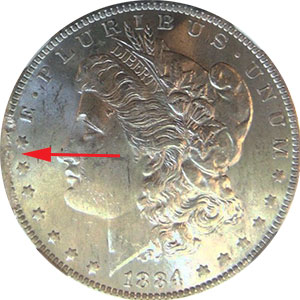
Rim Cud
See Cud
Obviously the proper alignment of the dies would have had an upright Liberty bust on the obverse, and when turned to the reverse the Eagle would also be upright. However, it was possible for a die to become slightly dislodged and rotated in the coin press and coins were struck with this misalignment until the problem was corrected.
Die rotation can be either clockwise or counterclockwise. Small rotations of 5% or less are fairly common and of little interest. But the closer the rotation approaches 90% the greater the interest.
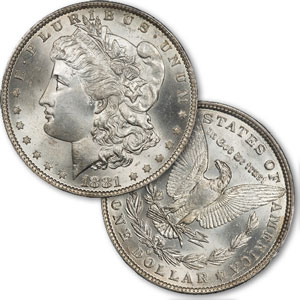
Repunched Date (RPD)
See Overdate
A repunched mint mark occurs when the Mint decided to reuse or repurpose a die with an existing mint mark for a different mint. The new mint mark would be punched into the die, but often would not completely obliterate the existing mark.
In the example to the right this is a Carson City die that has been reused to create a New Orleans die. The CC is still visible below and to the left and right of the O.
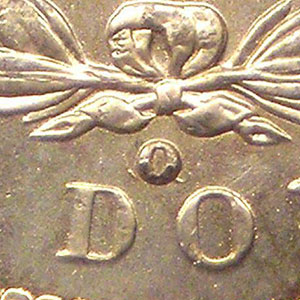
The SSDC is an association of collectors with shared interest in the collection and study of United States Silver Dollars.
Follow this like by clicking here to learn more about the association.

A slab is a plastic holder used by grading companies to encapsulate a graded coin. The three primary grading companies use different types as fits their marketing and other needs. However all three have standardized to almost the same size.
Today's slabs offer the collector some measure of security since the slabs now include holographic and other security features. Each encapsulated coin has a unique certification number and grade.
While not complete protection for the collector, this is light years ahead of where the hobby was twenty years ago.

Dr. Andrew Woods Smyth served as the director of the New Orleans Mint starting in 1885. Dr. Smyth was a noted physician and surgeon, but there is no record of having any experience to manage the Mint.
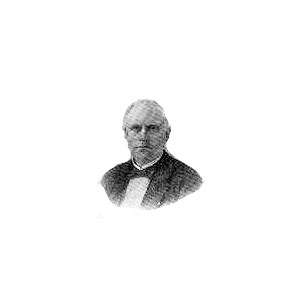
Spalling
See Pitting
Strike doubling is different than die doubling in that it is a mechanical result of the strike process and does not exist on the die prior to the strike. It is usually identifiable by the flatness of the underlying image. In die doubling there is more of a rounded appearance to both the top and bottom image.
This item goes by a lot of different names and might be called Shelf Doubling, Machine Doubling, or Machine Damage Doubling.
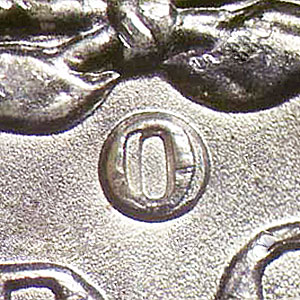
Striking is the actual process of converting a raw planchet into a coin. The upset planchet is placed in the coin press, held in place by the collar die over the anvil die, and then struck with the hammer die.
The process is done under tremendous pressure and actually causes the planchet to turn molten. The molten metal then flows into the dies and acquires the die detail. Once struck the planchet has become a legal tender coin.

When you see the term "Struck Through" it refers to any foreign object coming between the planchet and the die that causes some portion of the completed coin to be weak, missing, or show an impression of the foreign object. Sometimes this was as little as grease filling a date digit, but we have also seen tiny bits of wire impressions.
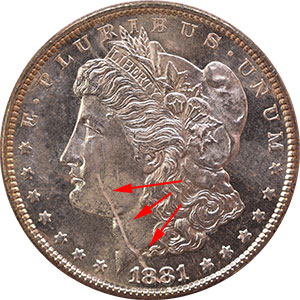
The talons are the eagle's claws that clutch the olive branch and arrow shafts. In many date series there are missing, doubled, or other misshapen talons. However, in the 1881-O series no talon related VAMs have been identified.
To see a complete list of reverse devices and features click here.
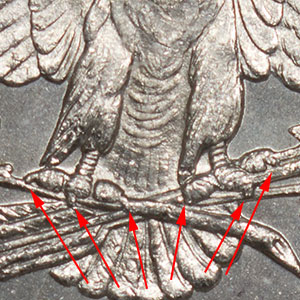
In 1996 the Top 100 Morgan Dollar Varieties was published by Dr. Michael Fey and Jeff Oxman. By identifying only the most significant VAMs the list seeks to better focus collectors on the most significant varieties. The authors are seeking to focus less on insignificant varieties and more on the major ones identified.
For the most part the book and list have refocused collectors on the core, important varieties. Many of the Top 100 VAMs are now considered necessary to have a complete Morgan Dollar collection.
Additionally, the Top 100 VAMs are recognized and slabbed by all three primary grading services. All of this has raised the awareness of VAMs and helped this area of collecting enter the mainstream.
Their book is now in its 4th edition. Unfortunately none of the 1881-O VAMs are on the list.
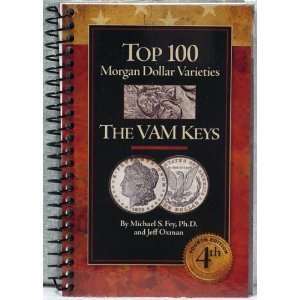
Third Party Grader (TPG)
One of the three primary grading services, see Authentication.
Upsetting
See Milling
The acronym VAM stands for "Van Allen" and Mallis" after the two founders of the identification system. Leroy Van Allen and George Mallis recognized that with all Morgan Dollars there were minor differences in each coin based on the pairing of the obverse and reverse dies. They also recognized that the unique circumstances surround the production and use of Morgan Dollars made the study and identification of these differences a hobby unto itself.
Today the VAM hobby has grown to include varieties that were probably unimaginable when the first VAMs were first identified. The Mint production methods and die creation have produced an area of infinite study for serious students of Morgan Dollars. Today no collection of Morgan Dollars would be complete without the inclusion of significant VAMs.
The study has the added attraction of historical connections, politics, wars, disease, and all the other human factors that go into a great story.
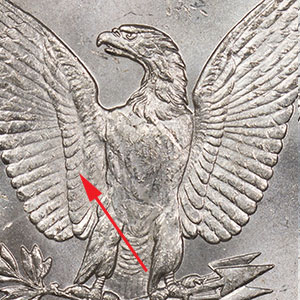
For each date and mint series there should be at least one coin struck with an obverse and reverse die pair that are "as intended" by the engraver and the Mint. Logically there must be at least one time that this happened, so this pairing is always assigned VAM 1. This is also the base state from which analysis for other variations should start. For most collectors you would assume that most Morgan Dollars are VAM 1 and that other coins exist but are rare. But for Morgan Dollars the opposite is true.
Interestingly we went a long time before we found a VAM 1 for the 1881-O series. The New Orleans Mint was not noted for its production quality and when coupled with the difficulty of making dies in 1881 there are many more other VAMs than VAM 1.
The coin on the right is a VAM 1, PCGS 26309096. It is an MS64 and one of our first VAM 1 coins.
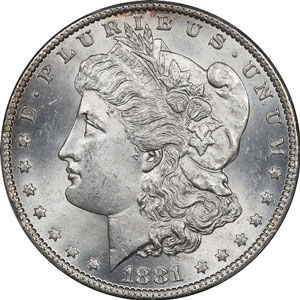
There are coins that bear interesting features but not ones associated with a die error. They could be interesting strike errors (production), post strike damage that was mistaken for a die error, or features considered too small to list.
All of these have been examined by Leroy Van Allen and found to be of this classification. On VAMworld these are cataloged so that other collectors can use them for comparison when working to identify their coin's VAM.
To see the complete list click here.

Wide Reeding
See Reeding.
Wizzing is a nice slang term that refers to wire brushing or polishing a coin to enhance its luster or eye appeal. It differs from dipping in that it is a mechanical and not a chemical process.
Poorly wizzed coins are easy to recognize, even without magnification, and this example is one of the worst.
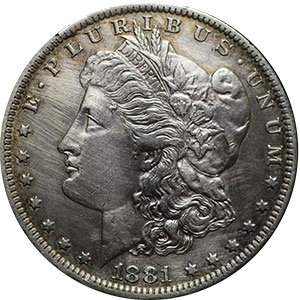
Getting Started
Collecting The 1881-O
The 1881-O VAMs


